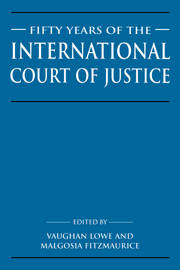Book contents
- Frontmatter
- Contents
- List of contributors
- Preface
- List of abbreviations
- Sir Robert Yewdall Jennings, by Vaughan Lowe
- List of publications of Sir Robert Jennings
- Table of cases
- Part I The International Court of Justice
- Part II The sources and evidences of international law
- Part III Substance of international law
- Part IV Procedural aspects of the work of the International Court of Justice
- Part V The International Court of Justice and the United Nations
- 32 The General Assembly, the International Court and self determination
- 33 The International Court of Justice and the Security Council
- Index
33 - The International Court of Justice and the Security Council
Published online by Cambridge University Press: 02 November 2009
- Frontmatter
- Contents
- List of contributors
- Preface
- List of abbreviations
- Sir Robert Yewdall Jennings, by Vaughan Lowe
- List of publications of Sir Robert Jennings
- Table of cases
- Part I The International Court of Justice
- Part II The sources and evidences of international law
- Part III Substance of international law
- Part IV Procedural aspects of the work of the International Court of Justice
- Part V The International Court of Justice and the United Nations
- 32 The General Assembly, the International Court and self determination
- 33 The International Court of Justice and the Security Council
- Index
Summary
What the International Court and the Security Council have in common is their status as principal organs of the United Nations and their participation in the settlement of disputes. These factors influence the various relationships between the two bodies.
This chapter begins by an analysis of the parallelism in the functioning of the Court and the Council (first section). One specific point of that topic is negotiations by parties to a dispute which is simultaneously subject to judicial proceedings (second section). Another problem pertaining to parallelism is co-ordination resulting from a Council recommendation under article 36, paragraph 3 of the Charter (third section). Recently, there arose the question whether the Security Council has changed its hitherto adopted stance of correlating its competences with those of the Court and, consequently, whether it would no longer hesitate to restrain the Court. Is this the lesson of Lockerbie? The matter is dealt with in the fourth section, while the fifth takes up the discussion on the related though more general issue of the existence or non-existence of an exclusive competence of the Security Council. Some attention has also been devoted to the hypothesis of a judicial review of the Council decisions (sixth section).
This writer does not comment on the Council measures to give effect to the Court's judgments (article 94, paragraph 2 of the Charter). This is mainly due to the necessity of keeping the size of this chapter within certain limits.
- Type
- Chapter
- Information
- Fifty Years of the International Court of JusticeEssays in Honour of Sir Robert Jennings, pp. 606 - 629Publisher: Cambridge University PressPrint publication year: 1996
- 2
- Cited by

